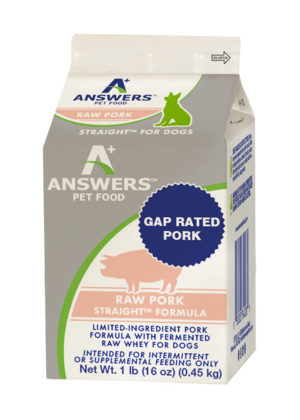Answers Pet Food Straight Raw Pork Formula For Dogs Review
PawDiet has been helping pet owners since 2015. To fund our efforts, articles may include affiliate links; if you buy something through a link, we may earn a commission.
Review of Answers Pet Food Straight Raw Pork Formula For Dogs
According to our most recent data, this product is intended for intermittent or supplemental feeding only.
Review of Ingredients
In our review of Answers Pet Food Straight Raw Pork Formula For Dogs, we'll examine all 7 ingredients and highlight the nutritional contribution of each ingredient.
While the first few ingredients typically dominate the recipe's composition, ingredients in small quantities can still have a meaningful impact on the overall nutritional profile of the recipe.
Pork is a high-quality source of protein, essential for muscle development and maintenance, and provides vital nutrients for your dog's overall health.
Pork liver is a nutrient-rich organ meat that provides a plethora of essential vitamins and minerals, including iron, vitamin A, and B vitamins, which help support your dog's overall health.
Pork Heart is an excellent source of protein, B vitamins, iron and essential amino acids, making it a beneficial component of your dog's diet.
Pork kidney is a nutrient-dense protein source for dogs, providing essential vitamins and minerals, including iron, zinc, and vitamins A and B. It supports overall health, including immune function, cognitive health, and energy production.
Ground pork bone is a natural source of calcium, phosphorus, and other essential minerals that promote strong bones and teeth in dogs. It also provides a crunchy texture that can help clean teeth and maintain dental health.
Whey is a protein-rich by-product of milk processing. It provides essential amino acids, which are the building blocks for healthy muscles in dogs.
While salt is a necessary component of a dog's diet, providing essential minerals such as sodium and chloride for proper cellular function, it should be provided in moderation to avoid health issues like hypertension or kidney damage.
Review of Guaranteed Analysis
Crude Protein (min) of 15.00%: The crude protein content is primarily derived from the pork, pork liver, pork heart, and pork kidney. These are all high-quality sources of protein that contribute to the overall protein content of the food. The liver, heart, and kidney are particularly rich in protein and also provide a variety of other nutrients. The ground pork bone may also contribute a small amount of protein, but its primary contribution is likely in minerals such as calcium.
Crude Fat (min) of 15.00%: The crude fat content comes from the pork, which naturally contains fat, especially if the cuts include more fatty portions. Organ meats like pork liver, heart, and kidney also have fat, though they are leaner than some muscle meats. Pork is known to have a higher fat content compared to some other meats, which likely explains the equal percentage of protein and fat in this formula.
Crude Fiber (max) of 2.00%: The crude fiber content in this raw diet is relatively low, which is typical for meat-based diets that do not include plant materials known for higher fiber content. The maximum of 2% crude fiber reflects that this is a meat-centric formula without significant inclusion of fruits, vegetables, or grains that would otherwise increase the fiber content. Any fiber present is likely incidental from the animal parts rather than from a dedicated fiber source.
Calories of 2470.00 per kg: The caloric content is a measure of the energy provided by the food. The high calorie count is influenced by the high levels of protein and fat, as both are calorie-dense nutrients. Fats provide more than twice the calories per gram compared to proteins and carbohydrates. Therefore, the equal crude fat and protein percentages suggest a balanced contribution to the overall caloric content, with fat being the more calorie-dense contributor.
Fermented raw whey is included in the ingredients, which may contribute to the protein content and potentially assist with digestion, but it is not a primary contributor to the guaranteed analysis values. Salt is added for taste and as an electrolyte but does not significantly alter the nutritional analysis.

